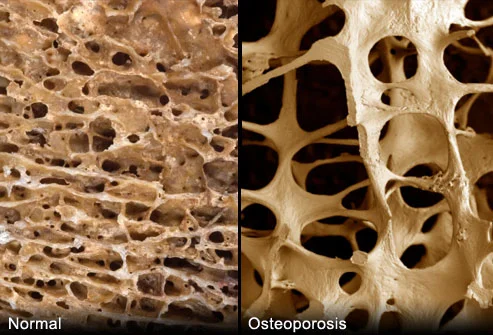Let's play a little game: I say "osteoporosis" and you think of the first thing that comes to mind. Did you picture a sweet, 80 year old grandma sitting in a hospital bed with a broken hip? Maybe! But did you know that over 9.9 million people in the United States have osteoporosis and another 43.1 million have osteopenia? I sure didn't until I started researching this post!
Okay, so a whole lot of people have it, but do you care about osteoporosis yet? What's that you say- NO!?!
You need to care because even though osteoporosis is usually diagnosed in women who are over 50, the process which causes osteoporosis starts when you are in your teens. We need to start thinking about osteoporosis RIGHT NOW, not in a few decades, not when you have broken a bone.
Need another reason to care? Studies have been showing us for a while now that doctors don't do a great job of screening for osteoporosis and even the ones that do tend to undertreat it until someone has a fracture. From a big picture perspective, this is a huge problem because we know that:
- 1 in 2 women will experience a fracture from osteoporosis in her lifetime
- having one fracture actually increases your risk of having ANOTHER fracture
- not exercising is a risk factor for fracture and if you have a fracture you probably will not be exercising (or will be exercising less)
- and about 10-20% of women will die from a fracture
Those are scary facts and I don’t know about you, but I don’t want to wait until I have a fracture to begin treatment!
Let’s start with the basics
Bone density is a measure of how thick your bones are. How dense your bones are is influenced by genetics, nutrition, overall health, hormone levels, and physical activity while growing up. Low bone density puts you at risk for fractures which are no beuno.
We all reach our peak bone density between 18 to 25 years old. After that we stay the same for a few years and usually by 30 we start losing bone density each year. That means that the best time to build up your bone density is while you are growing up, or between 12 and 25 years old. After that it's more maintaining/trying to slow down the rate of bone loss but not reversing it.
Our skeletons are constantly breaking down old bone and building up new bone. As we get older we end up breaking down more than we rebuild. Hormones also play a big role here, especially for women. Estrogen is a hormone which helps to build and maintain bones. After menopause, estrogen levels drop and bone health also plummets. Women experience a significant amount of bone loss in the decade after menopause!
At a certain point bone loss becomes substantial enough to call "osteopenia" (low density) and osteoporosis (brittle bones).
You can also develop osteoporosis as a result of certain diseases, medications, poor nutrition, drinking alcohol and smoking. About half of all people with osteoporosis have at least one of these factors, so speak with your doctor about the possible impact of your medical conditions/medications on your bone health.
How do you know if you have osteoporosis/osteopenia?
To diagnose osteoporosis/osteopenia you will need to have medical tests done. No one can simply look at you and know that you have osteoporosis. With that being said, you may be diagnosed with osteoporosis if you have a spontaneous fracture (meaning it happens out of nowhere and usually occurs in the spine) or a fracture after an event that shouldn’t have caused one (like a fall from a chair).
One of the most common tests is called a DEXA scan. This test identifies your bone mineral density, compares it against "normal" and assigns it a score. This is how to diagnose whether you have osteopenia or osteoporosis. However, it does not assess how quickly your bones remodel or the quality of the bone that you have which are important factors. This is recommended for all women over the age of 65.
The National Osteoporosis Foundation has also created a tool called FRAX which healthcare providers can use to determine a person's risk of fracture within the next 10 years. It takes into account bone mineral density (so you need the DEXA scan) and other factors such as age, sex, alcohol use, and previous fractures. People who are identified as medium to high risk should start treatment ASAP.
How can you improve your bone density?
CA/Vitamin D supplements
Calcium is stored in bones and keeps them strong and healthy. Your body also uses calcium for the heart, nerves, and muscles. To build up bones, your body needs enough calcium floating around between your cells to serve all those organs and to add to bone. If there is not enough to go around, then your body will take calcium from the bones, which weakens them.
About 70% of us aren’t getting enough daily calcium and Vitamin D from diet alone. In order to maintain healthy bones, you should be getting 1,200mg/day of Calcium and 800IU/day of Vitamin D. Calcium is tricky because you can only absorb 500mg at a time, so ideally you should be taking a couple doses per day. Calcium carbonate is cheaper but needs to be taken with meals because it requires acids to break it down in order to be absorbed. Calcium citrate is more expensive but does not need to be taken with meals. IN the case of Vitamin D, more is not better - there is such a thing as too much, so stick with the 800 IU/day max.
Exercise
One of the best steps you can take to protect your bones it to exercise regularly! Bones get stronger when they are loaded, which means any weight bearing activity. Bone also reinforces itself in areas which are being pulled on (i.e. where muscles attach). We can use this knowledge to our advantage and exercise to keep the bones healthy! And if you think about all the other benefits of regular exercise then it really is a no brainer!
The American College of Sports Medicine recommends that adults do weight-bearing endurance activities 5-7 days per week. That includes tennis, stair climbing, walking, jogging, jumping, basketball, and volleyball just to name a few. These have to be moderate to high intensity though, so think power walking, not "take a Snapchat every 10 feet" walking! Adults should also do resistance exercises of all major muscle groups 2 days/week, again at a moderate resistance (about 15 reps).
Don’t smoke and limit how much alcohol you drink
Before you panic, you should know that an occasional glass of sangria or a Lienenkugel on the beach isn't going to destroy your bones. But having >2-3 drinks/day will. Drinking that much every day will likely take a toll on other organs in your body as well. There is no "okay" amount that won't harm your body for smoking.
Speak with a healthcare provider about getting help if you want to quit smoking/drinking.
Talk to your healthcare provider!
Remember, preventing a problem is always easier than treating one! Don’t wait until you are that sassy 75 year-old with a hip fracture to talk to your medical providers about osteoporosis.
Resources:
Clinician's Guide to Prevention and Treatment of Osteoporosis. Cosman et al. Osteoporosis International. Oct 2014.
Diagnosis and treatment of osteoporosis. Gayle Sweet et al. Journal: American Academy of Family Physicians, Feb 2009.











